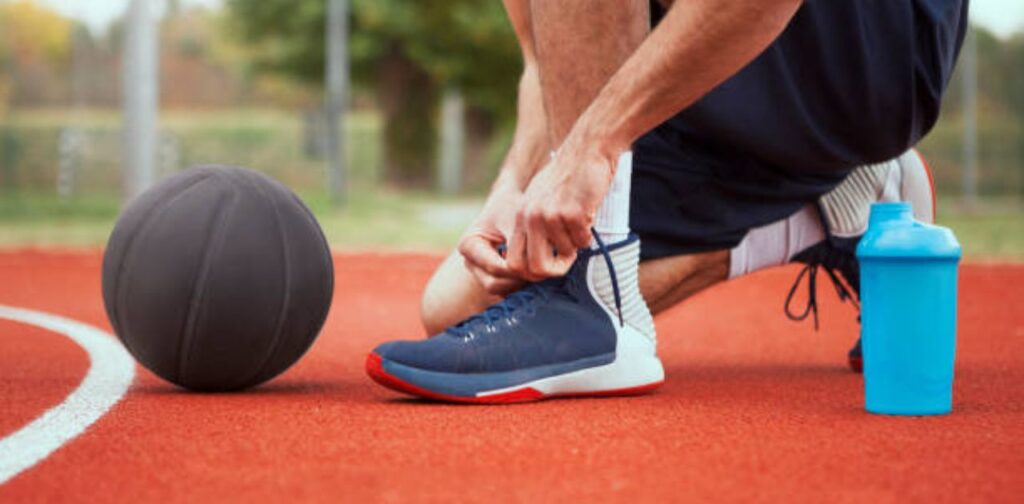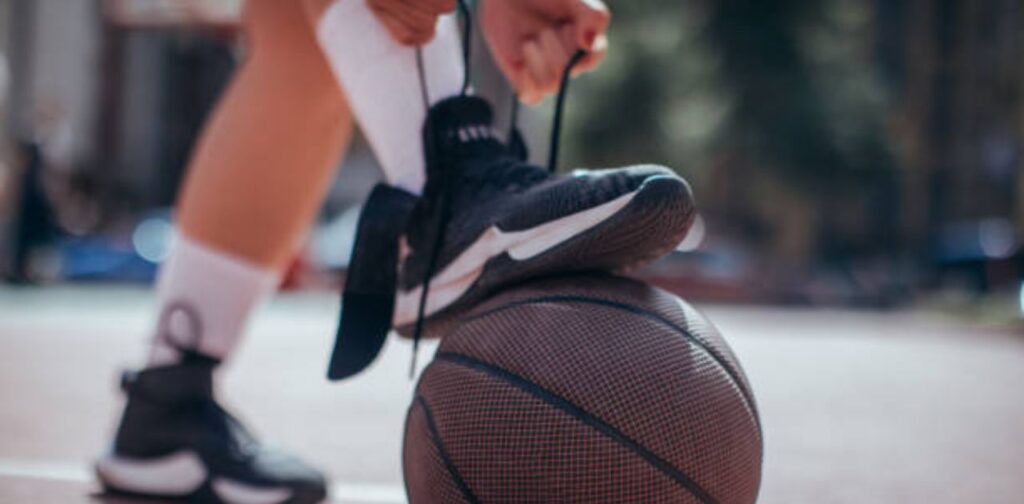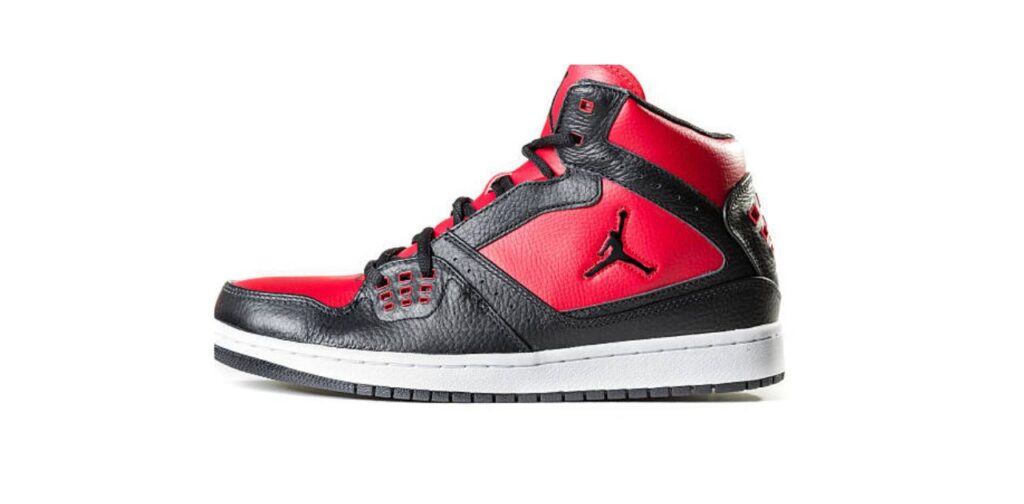Basketball is a game where every player must run like a horse around the court. Running and basketball are two different sports, each placing unique demands on athletes’ bodies. Many people think running with basketball shoes is the same as running with running shoes. Understanding the unique biomechanics and requirements of both running and basketball is crucial in determining the compatibility of basketball shoes for running.
There are many differences between basketball shoes and running shoes, and of course, there are also different types of basketball shoes and running shoes. When you explore various aspects of fitness, a common question arises: Are basketball shoes good for running? In this comprehensive article, we’ll examine basketball shoes and whether the shoes designed for the basketball court are suitable for running or not.

Anatomy of Basketball Shoes
Are basketball shoes good for running? Basketball shoes are more than just stylish footwear. They are designed to enhance performance, provide ankle support, and protect players’ feet during intense games. Here, we will discuss the anatomy of basketball shoes.
High-Top Design
The high-top design or upper portion of the basketball shoes is crucial for a player’s fitness, comfort, and support. The high-top design is typically made from synthetic materials, leather, or both. These materials provide support, energy, and flexibility to the player’s foot. The quarter of the upper part covers the sides and back of the foot. It provides stability and helps prevent ankle injuries during quick lateral movements. The tongue of the high-top protects the top of the foot and prevents the laces from rubbing against the skin. It plays a vital role in the player’s comfort playing on the court. The eyestay holds the eyelets (holes) through which the laces pass. Proper lacing ensures a secure fit on the player’s foot.

Mid-Sole Design
The midsole is the layer between the outsole (bottom) and the upper top design. Basketball involves frequent jumps and landings. The midsole, often made from foam or gel, provides essential cushioning and shock absorption. A well-designed midsole enhances stability during lateral movements and sudden stops.
Out-Sole Design
The outsole is the lower part of the shoe that makes contact with the court. It has three main components. The front part of the outsole provides traction during push-offs and quick sprints. The heel area ensures stability during landings and absorbs impact forces. The midfoot section supports the arch and aids in pivoting and cutting movements.

Features of Basketball Shoes: Are Basketball Shoes Good for Running
Are basketball shoes good for running? Whether you’re a professional player or a weekend warrior, understanding the critical features of basketball shoes can help you make the right choice. Let’s explore these features.
1. Ankle Support and Stability
Ankle support and stability are crucial for basketball players to perform well on the court. The high-top construction provides stability during lateral movements, jumps, and sudden stops on the court. Ankle support is helpful for overweight players or those returning to running after a hiatus. The reinforced ankle collar and strong traction help prevent ankle injuries.
2. Excellent Cushioning
Running on the court involves repetitive impact on players’ feet. When players take every step, their bodies experience shock, especially when their heels hit the ground. Basketball shoes often feature superior cushioning to absorb this impact. The combination of foam, gel, and other materials provides a comfortable and protective experience during short-distance runs.
3. Durability
Basketball shoes are built to withstand the rigours of the game. They are made long-lasting even when used for running. A pair of basketball shoes with excellent cushioning and a supportive upper can serve well during casual runs.

4. Straightforward Tracks
Basketball shoes are advantageous to use when you are running on a straightforward track. Their slightly heavier weight won’t hinder your forward motion, and the added stability can be useful. However, this recommendation applies primarily to short distances. For long distances, running shoes work better.
Danger of Running in a Basketball Shoe
Are basketball shoes good for running? Running is a fantastic way to stay fit, improve cardiovascular health, and clear your mind. With their high-top design, basketball shoes are essential for the fast-paced, lateral movements of the court. However, these same features can pose risks when it comes to running. In this article, we’ll explore why using basketball shoes for running may not be the best idea and uncover potential dangers that runners should be aware of.
1. Weight and Bulkiness
The weight of basketball shoes is slightly higher than that of running shoes. While the weight of basketball shoes provides stability, it can become inconvenient during longer runs. Dedicated running shoes are better if you’re a passionate runner logging significant weekly mileage.
2. Lack of Flexibility
Basketball shoes prioritize lateral movement, so they may not offer the flexibility needed for efficient running. The rigid sole and midsole can hinder your foot’s natural motion during the gait cycle. For optimal performance, running shoes with a more flexible design are preferable.

3. Traction Concerns
Basketball shoes have specialized traction patterns for court grip. While this is essential for quick cuts and pivots, it may not translate well to running surfaces. The same traction that keeps you steady on the hardwood can cause unnecessary drag on asphalt or concrete.
4. Fit Matters
Regardless of the shoe type, a proper fit is crucial. If your basketball shoes fit snug but not tight, they can work for short runs. However, ill-fitting shoes can lead to discomfort, blisters, and injuries. Always prioritize fit over style.
FAQs
1. Can I use basketball shoes for long-distance running?
You can run in basketball shoes, but it’s not ideal for long distances. Basketball shoes are heavier, less flexible, and lack the specialized cushioning for extended runs. However, wearing basketball shoes can protect your feet and enhance your performance.
2. Can using basketball shoes for running affect players performance on the court?
Yes, excessive use for running may impact basketball shoes’ traction and support features, potentially affecting players’ performance on the court. It’s advisable to reserve basketball shoes primarily for their intended purpose.
3. Are there specific scenarios where basketball shoes are suitable for running?
Yes, basketball shoes are suitable for short-distance running or interval training. Their stability and ankle support can also benefit quick sprints or agility drills.
4. Do high-top basketball shoes offer better ankle support for running?
High-top basketball shoes are designed to support lateral movements and protect against ankle injuries on the court. However, excessive ankle support may restrict natural foot movement during running. Low-top shoes or dedicated running shoes might be more suitable for longer runs.
5. What are the potential risks of using basketball shoes for running?
Using basketball shoes for running may increase the risk of discomfort, blisters, or even injury due to the different demands of the two activities. Running shoes are engineered to absorb impact and facilitate a smooth gait, which may not align with the design of basketball shoes.
Conclusion
Are basketball shoes good for running? In conclusion, basketball shoes are suitable for running depending on personal preferences, running style, and goals. However, basketball shoes are not considered the best option for running due to their heavy structure and lack of flexibility. Unlike general basketball shoes, running shoes are designed to provide optimal comfort and minimize long-distance burdens. As well as discomfort, running with basketball shoes can cause severe problems with the feet and legs, including plantar fasciitis and shin splints.

